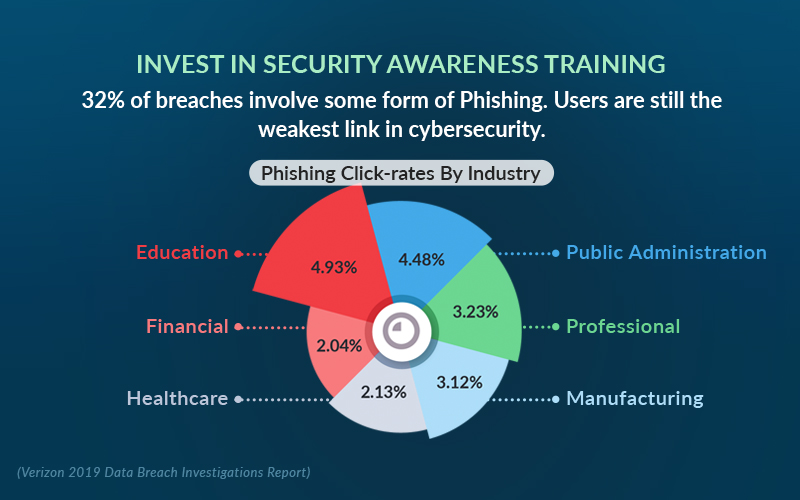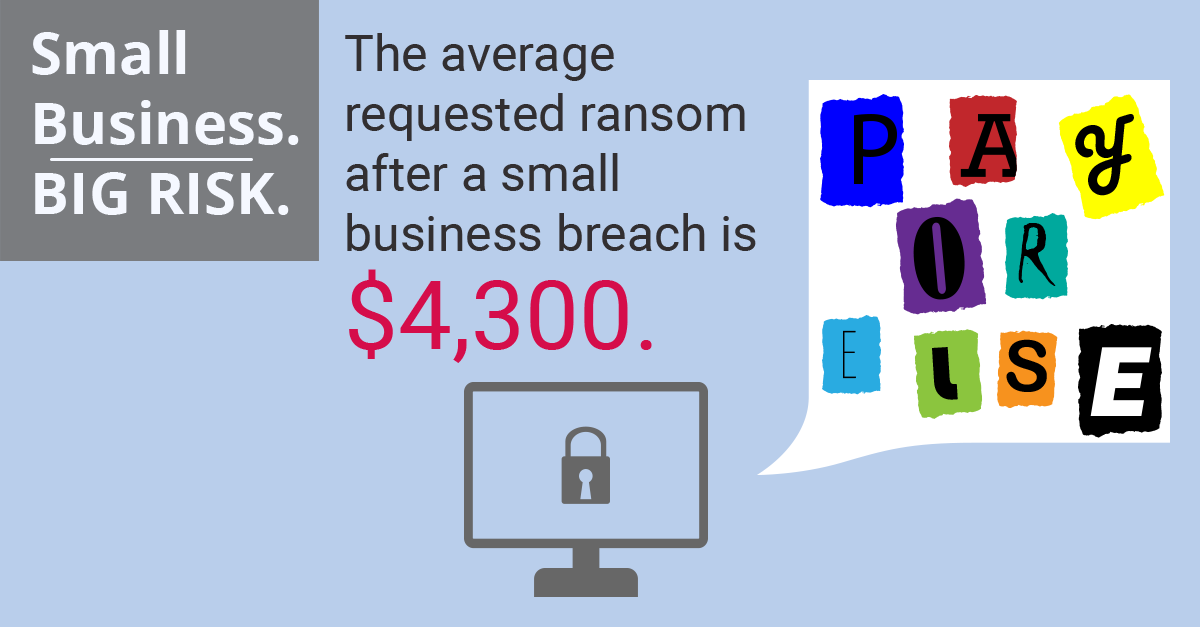A Guide to Security Awareness Training for Businesses
Users are the weakest link in security — Do you have Cyber Security Awareness Training your Employees?
Security Awareness Training for Employees
Training employees about security helps keep your business safe. It teaches them how to spot and avoid cyber threats. Important topics include phishing scams, how to keep passwords safe, and safe internet practices. Regular training keeps your team updated on the latest threats and shows them how to react. This reduces the chance of data breaches and cyberattacks.
What Is Security Awareness Training
Cybersecurity awareness training is crucial for teaching employees how to protect themselves and the company from cyber attacks.
This training includes two main parts. First, there are cybersecurity awareness training courses. These online courses prepare employees for the cyber threats they are most likely to encounter. The program includes computer-based training, interactive exercises, and assessments that cover key cybersecurity topics every employee should understand.
The second part of the training is simulated phishing training. In this program, employees receive realistic phishing emails to see how they respond. If an employee clicks on a phishing email or shares sensitive information, they receive immediate training to help them avoid such attacks in the future.
A solid cybersecurity awareness training program teaches employees about company policies related to technology. Employees should know whom to contact if they notice a security threat and understand that data is a valuable company asset. Regular training is especially important for organizations with high turnover rates or those that hire many temporary workers.
Measuring the effectiveness of the training can be challenging. One common way is to track a decrease in the number of security incidents over time.
While small and medium businesses may not need this training for compliance, it is beneficial for them to train employees to steer clear of cyber incidents like phishing attacks and account takeovers.
61%
of businesses reported a cyberattack in the last year — does your business have a cyber readiness plan?
Why Security Awareness Training Is Important
Many businesses struggle to keep their operations secure as technology changes rapidly. A recent survey found that 63% of professionals feel they don’t receive enough security training to manage risks. For the third straight year, the number of security incidents caused by human error is increasing. As the pace of learning falls behind new technology, employee training in security becomes one of the most important ways to protect your organization.

What Is the Main Purpose of Security Awareness Training?
A security awareness training program should have three main goals:
- Educate employees and encourage behavior change: The training should provide relevant resources tailored to different industries and job roles, making it engaging for everyone in the organization.
- Empower employees to spot and report phishing attacks: Create simulated phishing campaigns to help employees learn how to recognize and avoid dangerous phishing threats.
- Track compliance, assess security risks, and demonstrate training success: Start by establishing a baseline. The training platform should easily track and share your organization’s compliance score and phishing rates. Pre-made reports and charts should help you see behavior trends over time and show the effectiveness of your program at the organizational, departmental, and individual levels.

The methods to achieve these objectives include:
- Training content should be mapped to the National Institute of Standards and Technology (NIST) cybersecurity framework.
- Reporting, analytics and security assessments to quantify training impact and detect employee-related risks before breaches occur.
- Ongoing support in program implementation and design, execution and reporting.
Why Security Awareness Education and Training Is Important Within Organizations
Most cyberattacks target small and medium-sized businesses. In fact, 60% of small businesses shut down within six months of a cyberattack. For organizations that have had a data breach or ransomware attack, the value of security awareness training is clear. However, for those that only provide training to comply with regulations, or for businesses that have never offered employee training, the benefits might seem less obvious.
With many organizations facing underfunded IT and security teams, it’s important to ask, “Do the benefits of Security Awareness Training outweigh the costs?” Security Awareness Training doesn’t generate revenue directly; instead, it saves money by lowering the risk of cyber incidents.
Creating a layered awareness and training program and fostering a culture of cybersecurity requires planning, but it’s not overly complicated. Verity IT provides several Security Awareness Training options.
Research shows that employees who receive Security Awareness Training are much better at recognizing security threats than those who don’t. Additionally, since 32% of breaches involve phishing attacks, which most security tools can’t defend against, it’s no wonder that NIST advises all organizations to provide Security Awareness Training.
Is Free Security Awareness Training Okay for My Business?
Your business is likely your most valuable asset, followed closely by your employees. Investing in a security training and threat awareness program is clearly worthwhile. So, why settle for free options that won’t provide the proper education, tools, and reports needed to protect your most important asset?
When It Comes to Security, USERS Are the Weakest Link — Are You Training Your Team to Recognize Cyberthreats?
How to Train Employees on Cybersecurity
Creating a perfect security awareness program that ensures your team never clicks on a suspicious link or downloads a harmful attachment is tempting. However, security awareness is not an all-or-nothing effort. Building a strong human firewall through Security Awareness Training relies on small, incremental improvements. Following best practices can help you achieve these gains and strengthen your defenses.
Instead of just aiming for awareness, focus on inspiring your team to change their behavior to protect the organization from security threats. This begins with improving skills, but your team must also feel motivated to put security best practices into action. Simple actions, like sharing your interest in security, rewarding positive behaviors, and celebrating small successes, can encourage your team and promote lasting change.
Think about the message you want to send, when to send it, and through which channels. Pay attention to how often you communicate, the relevance of your information, and how engaging your content is.
Support from upper management is vital for the success of your security awareness program. Make sure executives understand your efforts clearly. When leaders view security awareness as essential to the organization’s success, it becomes easier to prioritize and support your program.
Monitor your progress to ensure your expectations are met. Use all available data to gauge how well your security awareness initiatives are doing. Track participation in training, success in phishing tests, and assessment scores. Analyzing these metrics will help you make better strategic and tactical decisions and demonstrate the program’s value to the organization.
One-time training sessions and annual requirements are not enough. You need a flexible, ongoing plan to maintain security awareness and promote long-term behavioral changes. Remember that lasting changes take time, so design your Security Awareness Program to last at least a year to keep security awareness in focus and encourage lasting change.
Don’t get caught by phishing scams!
Let’s set up defenses that actually work.
What Should a Security Awareness Program Include?
A successful security awareness program should cover key cybersecurity topics, provide practical training, and offer continuous education for employees. But how do you run an effective program, and what are the most important areas to focus on?
Using a well-established framework like NIST (National Institute of Standards and Technology) can help you build and mature your program. NIST provides comprehensive security guidelines to ensure your employees are equipped to recognize and respond to potential cyber threats.
What Is NIST?
The National Institute of Standards and Technology (NIST) is part of the U.S. Department of Commerce. NIST helps improve innovation and competitiveness in various industries by setting measurement standards, conducting research, and developing frameworks. This includes creating guides to help organizations improve their Security Awareness Training Programs.
Security Awareness Training Topics
NIST Special Publication 800-50 suggests that security awareness training should cover the following nine topics:
- Phishing
- Password security
- Safe web browsing
- Social engineering
- Malware
- Mobile security
- Physical security
- Removable media
- Working remotely
These topics provide a basic training guideline for all employees and should be part of your small business IT support.
The ROI of Phishing Training
Investing in security awareness training provides a strong return on investment (ROI) by preventing expensive data breaches and reducing business interruptions. A 2024 IBM report states that the average cost of a data breach is $4.88 million. In contrast, the cost of phishing training programs is much lower, usually between a few hundred and a few thousand dollars per employee. Training helps employees spot phishing attempts, weak passwords, and social engineering attacks, which often lead to breaches.
Cost Breakdown:
- Data Breach Costs: Data breaches can lead to legal fees, fines, loss of customer trust, and recovery costs. They also create downtime that can hurt revenue. For example, a ransomware attack can cause an average downtime cost of $1.85 million.
- Training Costs: Ongoing employee education costs between $300 and $3,000 per employee each year, depending on the provider and training depth.
Key ROI Insights:
- Risk Reduction: Training can reduce the chance of breaches by up to 70%, lowering financial losses.
- Compliance: Many industries require security awareness programs for compliance (e.g., HIPAA, GDPR). The fines for non-compliance are often much higher than training costs.
- Long-Term Savings: Trained employees are less likely to fall for phishing scams or make accidental errors that lead to breaches, saving the company money over time.
Training employees in cybersecurity can save money and reduce risks. It also helps your business become more resilient to phishing attacks and malware.
The seven key parts of security awareness are:
- Password Security and Management: Create strong and unique passwords and keep them private. Use multi-factor authentication and change passwords regularly to stop unauthorized access.
- Phishing and Social Engineering Awareness: Learn how to spot and avoid phishing attempts, fake emails, and other tricks that try to get you to share sensitive information or install harmful software.
- Data Protection and Confidentiality: Protect sensitive data, such as personal, financial, and business information. Handle, store, and dispose of data properly and comply with regulations like GDPR or HIPAA.
- Physical Security: Keep physical items like computers, servers, and documents secure. Lock devices when you step away, use access cards correctly, and be aware of unauthorized people in secure areas.
- Safe Internet and Email Practices: Be careful when browsing the internet and checking emails. Avoid suspicious websites, don’t click on unknown links or attachments, and be cautious about downloading unverified software.
- Mobile Device Security: Understand the risks of using mobile devices. Secure them with passwords, encryption, and updates. Be careful when using public Wi-Fi.
- Incident Reporting and Response: Report security incidents or suspicious activities quickly to the right people. Knowing how to report helps reduce risks promptly and effectively.
These parts work together to build a strong sense of security awareness.
Get Your Free IT Cost Reduction Analysis
Identify Potential Savings with Our No-Obligation Assessment.
Security Awareness Training Best Practices
Security Awareness Training for Chicago Businesses
Security Awareness Training for Chicago Businesses How Cybersecurity Training Can Save Your Chicago Business from the Next Big Attack What is Security Awareness Training and Why is it Essential for Chicago Businesses? Security Awareness Training educates employees on how to…
Continue Reading Security Awareness Training for Chicago Businesses
The Role of Employees in Cybersecurity
The Role of Employees in Cybersecurity Empowering Your Team: Best Practices for Employee-Driven Cybersecurity In today’s world, cybersecurity is not just the responsibility of IT departments. Every employee plays a crucial role in safeguarding a company’s systems and data. The…
Employee Training to Prevent Phishing Attacks
Employee Training to Prevent Phishing Attacks A Critical Measure for SMBs Small and medium-sized businesses (SMBs) face an increasing number of cybersecurity threats. Among these, phishing attacks remain one of the most pervasive and damaging. According to the Verizon Data…
Continue Reading Employee Training to Prevent Phishing Attacks
What Is Ransomware? The Must-Knows.
What is Ransomware? Ransomware Explained: How It Works and How to Defend Against It What Is Ransomware and How Can You Defend Against It? Ransomware is a word no business wants to hear. It’s a type of malicious software designed…
7 Reasons Why Security Awareness Training Is Crucial
7 Reasons Why Security Awareness Training Is Crucial for Protecting Your Business The Power of Security Awareness Training: Protect Your Business from Cyber Threats Your employees—whether they’re at the office or working remotely—are often the first line of defense. Without…
Continue Reading 7 Reasons Why Security Awareness Training Is Crucial






